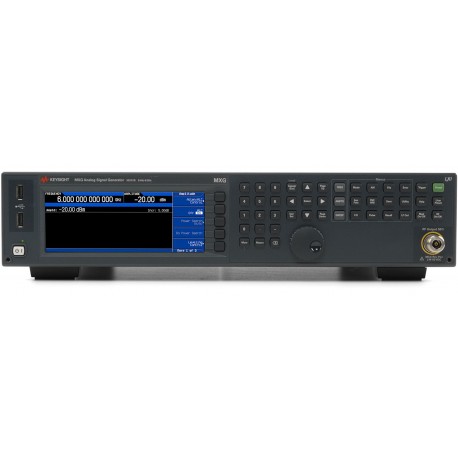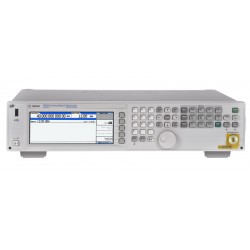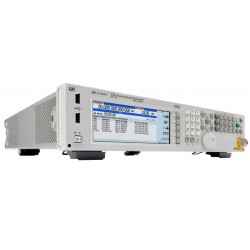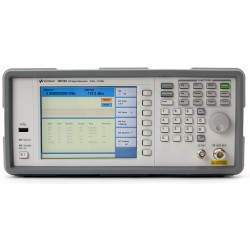- Standard phase noise
- Standard output power, +18 dBm
- Electronic attenuator
- CW signal generation
- 50-W reverse power protection
- Country-specific power cord
- Documentation set (CD-ROM)
- 3-year return-to-Keysight warranty
No products
Product successfully added to your shopping cart
There are 0 items in your cart. There is 1 item in your cart.
Keysight (Agilent) RF Signal Generators
- EMC Test Equipment
- Transient Generators
- RF Power Amplifiers
- DC - 300 kHz RF Amplifiers
- 10 kHz - 250 MHz RF Amplifiers
- 10 kHz - 400 MHz RF Amplifiers
- 10 kHz - 1 GHz RF Amplifiers
- 80 MHz - 1 GHz RF Amplifiers
- 1 GHz - 2 GHz RF Amplifiers
- 700 MHz - 4.2 GHz RF Amplifiers
- 1 GHz - 6 GHz RF Amplifiers
- 2 GHz - 8 GHz RF Amplifiers
- 6 GHz - 18 GHz RF Amplifiers
- 18 GHz - 40 GHz RF Amplifiers
- Pulse Amplifiers
- RF Field Strength Probes & Meters
- RF Conducted Immunity
- EMC Receivers/EMI Analyzers
- EMC Antennas
- Coupling Decoupling Networks (CDN's)
- Line Impedance Stabilization Networks (LISN's)
- RF Test Equipment
- EMC Probes
- EMC Measurement & Equipment Software
- Power Supplies
- Electrical Safety Analyzers
- High Precision Laboratory Power Analyzers & Meters
- Anechoic Chambers
- Over-the-Air (OTA) Test Chambers
- EMI RF Shielded Tent Enclosures
- RF Shielded Rooms
- EMC Absorber
- Positioning Equipment
- EMC/EMI Test Setup
- GTEM Cells / TEM Cells
- Reverberation Chambers
- Used RF Anechoic Chambers
- EMC Chamber Filters
- EMC Chamber Shielding Gaskets
- RF Shielded Doors
- Anechoic Chamber Accessories
- Fully Anechoic (FAR) Test Chambers
- Manufacturers
- 3ctest
- AE Techron
- AH Systems
- Amplifier Research
- Boonton
- Com-Power
- Diamond Engineering
- EM Test (Ametek CTS)
- EMC Partner
- EMC Test Design
- Empower High Power RF Amplifiers
- ETS-lindgren
- Log Periodic Dipole Array Antenna
- Near Field Probe Sets
- Double Ridge Horn Antennas
- Biconical Antennas
- Quad Ridge Horn Antennas
- Electric Field Probes
- GTEM's
- Positioners & Tripods
- Loop Antennas
- Biconilog Antennas
- LISN's (Line Impedance Stabilization Network)
- Shielded Enclosures/Rooms
- Monopole Antennas
- Field Generating Antennas
- Fischer Custom Communications
- Haefely Hipotronics
- Haefely EFT/Burst Immunity Test Systems
- Haefely Surge Combination Wave Test Systems
- Haefely Surge Damped Oscillating Wave Test Systems
- Haefely Electrostatic Discharge Test Systems (ESD)
- Haefely Surge Ring Wave Test Systems
- Haefely Surge Telecom Wave Test Systems
- Haefely Magnetic Field Test Systems
- Haefely CDN's (Coupling/Decoupling Networks)
- IFI Amplifiers
- Keysight (Agilent)
- MVG - Microwave Vision Group
- PMM / Narda
- Rohde & Schwarz RF Test Equipment
- Rohde & Schwarz Broadband RF Amplifiers
- Rohde & Schwarz Spectrum Analyzers
- Rohde & Schwarz Compliant EMI Test Receivers
- Rohde & Schwarz Isotropic RF Probes
- Rohde & Schwarz RF Signal Generators
- Rohde & Schwarz RF Switches
- Rohde & Schwarz Oscilloscopes
- Rohde & Schwarz RF Power Meters
- Rohde & Schwarz RF Power Sensors
- Schloder
- Schwarzbeck Mess-Elektronik
- Schwarzbeck Antennas
- Schwarzbeck Automotive Antennas
- Schwarzbeck Broadband Horn Antennas
- Schwarzbeck Biconical Antennas
- Schwarzbeck Logarithmic Periodic Broadband Antennas
- Schwarzbeck Stacked Log-Periodic Broadband Antennas
- Schwarzbeck Biconic Log-Periodic Antennas
- Schwarzbeck Dipole Antennas
- Schwarzbeck Rod Antennas
- Schwarbeck Antenna Baluns / Holders
- Schwarzbeck LISN Line Impedance Stabilisation Networks
- Schwarbeck Decoupling & Absorbing Clamps
- Schwarzbeck Field Probes
- Schwarzbeck Helmholtz Coils
- Schwarzbeck Antenna Masts
- Schwarzbeck Coupling/Decoupling Networks
- Schwarzbeck Antennas
- Solar Electronics
- Teseq (Schaffner)
- Teseq Automotive Transient Generators
- Teseq RF Test Equipment
- Teseq EFT/Burst Generators
- Teseq RF Immunity Generators
- Teseq ESD Guns
- Teseq Surge Generators
- Teseq Harmonics & Flicker Solutions
- Teseq Dips, Interrupts & Variations Equipment
- Teseq Ring Wave Generators
- Teseq Oscillatory Waves Generators
- Teseq Absorbing Clamps / Ferrite Tube
- Teseq EMC Antennas
- Teseq Current Probes
- Teseq Coupling Networks
- Thermo Keytek
- Vicreate
- Compliance Standards
- International (IEC/EN)
- EN/IEC 61000-3-2
- EN/IEC 61000-3-3
- IEC 61000-3-11
- IEC / EN 610000-3-12
- EN/IEC 61000-4-2
- EN/IEC 61000-4-3
- EN/IEC 61000-4-4
- EN/IEC 61000-4-5
- EN/IEC 61000-4-6
- EN/IEC 61000-4-7
- EN/IEC 61000-4-8
- EN/IEC 61000-4-9
- EN/IEC 61000-4-10
- EN/IEC 61000-4-11
- EN/IEC 61000-4-12
- EN/IEC 61000-4-16
- EN/IEC 61000-4-18
- EN/IEC 61000-4-19
- EN/IEC 61000-4-20
- EN/IEC 61000-4-21
- EN/IEC 61000-4-29
- EN/IEC 61000-4-31
- IEC 61000-4-39
- EN/IEC 62132
- SEMI F47 Voltage Sag Immunity
- Product Standards
- Military & Aerospace Standards
- Automotive EMC Standards
- CISPR Standards
- Telecom Testing
- ANSI/IEEE Standards
- FCC Part 15
- FCC Part 30
- International (IEC/EN)
- Application/Test Type
- Radiated Immunity
- Bulk Current Injection Testing
- RF Emissions Testing
- Conducted Immunity
- Conducted Emissions
- Antenna Pattern Measurement
- CE Mark Testing
- Intentional Radiator Testing
- Pulsed HIRF Radar
- Over-the-Air (OTA) Testing
- 5G Test Solutions
- Automotive EMC
- SAR Measurement Equipment
- Radiated Emissions
- Battery Simulator Test Equipment
- Services
- Clearance
Viewed products
-

Keysight N5181B with...
9 kHz to 3, or 6 GHz Pulse train...
-

Com-Power CLCI-100...
10 KHz to 100 MHz Frequency Range...
Keysight N5181B with Opt UNU and UNT MXG X-Series RF Analog Signal Generator
New
- 9 kHz to 3, or 6 GHz
- Pulse train generator
- Industry-leading ACPR, EVM, and output power
- Phase noise (-146 dBc @1 GHz)
- Factory-equalized 160 MHz bandwidth (+/- 0.2 dB flatness)
- Making Multi Channel Synchronization Power Measurements
- X-Series Multi-Function Generator Video
- RF Pulse Power Analysis with USB Power Sensors & FieldFox Analyzers
What's Included
PDF Downloads
Test Equipment Description
MXG X-Series Signal Generators
Specifications represent warranted performance of a calibrated instrument that has been stored for a minimum of 2 hours within the operating temperature range of 0 to 55 °C, unless otherwise stated, and after a 45 minute warm-up period. The specifications include measurement uncertainty. Data represented in this document are specifications unless otherwise noted.
Typical (typ) describes additional product performance information that is not covered by the product warranty. It is performance beyond specifications that 80 percent of the units exhibit with a 90 percent confidence level at room temperature (approximately 25 °C). Typical performance does not include measurement uncertainty.
Nominal (nom) values indicate the expected mean or average performance, or an attribute whose performance is by design, such as the 50 ohm connector. This data is not warranted and is measured at room temperature (approximately 25 °C).
Measured (meas) describes an attribute measured during the design phase for purposes of communicating expected performance, such as amplitude drift vs. time. This data is not warranted and is measured at room temperature (approximately 25 °C).
| Specifications For complete specifications details please click here | |
| Performance Level | ◆◆◆◆◇◇ |
| Output Power @1 GHz | -144 dBm to +26 dBm |
| Phase Noise @1 GHz (20 kHz offset) | -146 dBc/Hz |
| Frequency Switching | ≤ 800 盜 |
| Harmonics @1 GHz | |
| IQ Modulation BW Internal/External | n/a |
| Non-Harmonics @1 GHz | -96 dBc |
| Sweep Mode | • List • Step |
| Baseband Generator Mode | n/a |
| Software-General Purpose | • AM, FM, PM • Pulse • Pulse Train Generator |
| Software-Cellular/Wireless Connectivity | n/a |
| Software-Audio/Video Broadcasting | n/a |
| Software-Detection/Positioning/Tracking/Navigation | n/a |
| Waveform Playback Memory | n/a |
| Frequency Modulation-Maximum Deviation @1 GHz | 4 MHz |
| Frequency Modulation-Rate @100 kHz Deviation | DC to 7 MHz |
| Phase Modulation-Maximum Deviation | 0.5 rad to 8 rad |
| Phase Modulation-Maximum Deviation in High-BW Mode | 0.05 rad to 0.8 rad |
| Amplitude Modulation-Maximum Depth | 100% |
| Amplitude Modulation-Rate | 0 to 50 kHz |
| Applications Available | Yes |
| Analog | Yes |
Discover X-Series signal generation

Industry-leading performance
From 9 kHz to 6 GHz, the analog and vector MXG and EXG signal generators deliver unmatched performance in five key categories: phase noise and spectral purity, bandwidth, EVM, ACPR, and output power
Advanced real-time applications
Perform advanced receiver testing compatible with the latest standards using the MXG or EXG and Signal Studio software: define signal parameters, transfer them to the instrument, and use closed-loop or interactive control during signal generation.
Lower cost-of-ownership
X-Series signal generators are designed for high reliability and simplified service. One key example is the self-maintenance strategy: if onsite repairs are ever needed, they can be completed in less than two hours with our refurbished-parts exchange program.
Generate True Performance
To know your device’s behavior, you’ll take many paths. That’s the idea behind the Keysight Technologies. Inc. X-Series signal generators. They produce the signals you need—from simple to complex, from clean to dirty—to test your design within and beyond its limits.
The X-Series is crafted to create signals capable of testing your very best devices. From the pure and precise MXG to the cost-effective EXG, the X-Series helps you generate true performance.
To help you quickly create signals that meet the needs of specific standards and measurements, the MXG and EXG are compatible with Keysight Signal Studio software. Its suite of signal-creation tools addresses cellular communications, wireless connectivity, audio, video, positioning, tracking, and general-purpose applications.
To reduce cost of ownership, the X-Series signal generators are designed for high reliability and fast, easy calibration, service, and repair. Today’s MXG and EXG leverage technology used in previousgeneration MXG signal generators, which are among the most reliable signal sources ever offered by Keysight.
Internal channel corrections enhance bandwidth and accuracy |
The EXG and MXG provide modulation bandwidths to 120 or 160 MHz, respectively. This wide modulation bandwidth is available with EVM up to 0.4 percent and flatness up to ± 0.2 dB, ample performance for even the most demanding design tasks. The X-Series achieves this combination of bandwidth and accuracy through the use of a proprietary baseband ASIC and a factory-calibrated channel correction technique that extend from the baseband I/Q modulator to the RF output. Together, these technologies minimize I/Q errors to provide high modulation accuracy plus wide modulation bandwidth without user intervention such as manual I/Q adjustment. |
Take Your Devices to the Limit
Pure and precise
MXG On the path to better performance, the pure and precise MXG X-Series signal generators are fine-tuned to be your “golden transmitter” in R&D. Whether you’re pushing for a linear RF chain or an optimized link budget, the analog and vector MXG models deliver the performance and capabilities you need: phase noise, ACPR, channel coding, and more.
Use the MXG to test radar receiver sensitivity, characterize ADC or mixer SNR, or find receiver out-of-band rejection capability. You’ll get excellent results with industry-leading phase noise of –146 dBm at 1 GHz and spurious performance of –96 dBc at 1 GHz. You can also drive power amplifiers and characterize nonlinear behavior with industry-leading output power of +27 dB and ACPR of –73 dBc (W-CDMA test mode 1, 64 DPCH).
With EVM up to 0.4 percent (802.11ac and LTE) and factory-equalized 160 MHz RF bandwidth with flatness of less than ± 0.2 dB, the MXG enables testing and characterization of multicarrier power amplifiers or wideband receivers and components, such as those used in 802.11ac WLAN designs.
Industry-leading phase noise |
The MXG implements a new triple-loop phased-lock loop (PLL) design and “frequency plan” that results in substantial phase noise improvements close to the carrier and at wide offsets. The frequency plan addresses several key attributes: the choice of oscillator and reference frequencies in the synthesizer and the associated frequency conversion (mixers and multipliers) and filtering. The triple-loop approach allows optimized frequency spacing that ensures effective filtering of nonlinear artifacts such as images by pushing them outside the bandwidth of the synthesizer circuits. In the MXG, the plan arranges the frequency references and conversions such that the largest are far from the desired frequencies and modest filtering can heavily attenuate the remaining spurious signals. |
Meet your toughest requirements
The MXG is designed to keep pace with your ongoing search for greater performance. In consumer wireless, military communications, or radar, performance gains can help you mitigate interference, accelerate data throughput, or enhance receiver sensitivity.
Overcome interference problems | Accelerate data throughput | Enhance receiver sensitivity |
| In wireless, interference mitigation is becoming more difficult with the proliferation of users, devices, and standards. In the development of power amplifiers, the MXG helps minimize interference with less distortion by providing –73 dBc ACPR (W-CDMA test model 1, 64 DPCH) and +27 dBm output power. | Meeting throughput expectations at the edge of the network is becoming more challenging with LTE-Advanced and 802.11ac WLAN. With 160-MHz bandwidth and EVM up to 0.4 percent, the MXG helps you keep pace with present and emerging standards. | With the latest generation of radar systems, the challenge is to locate small, low-mobility targets—and one of the keys is enhanced receiver sensitivity. By providing unsurpassed phase noise of –146 dBc/Hz (1 GHz, 20 kHz offset) and spurious of –96 dBc (1 GHz) the MXG makes it possible to see the true performance of advanced radar systems. |
 |  |  |
Get the Right Performance at the Right Price
Lower operating costs |
To reduce your total cost-ofownership, the X-Series is designed for high reliability as well as fast, easy, and cost-effective calibration, service, and repair. To maximize uptime, today’s MXG and EXG signal generators leverage technology used in the previous-generation MXG, which has a mean time between failures (MTBF) of 116,000 hours To help you minimize downtime and service costs, the MXG and EXG include advanced self-maintenance capabilities such as full internal root-cause self-diagnostics. The recommended three-year calibration cycle and self-maintenance strategy will help reduce support costs and increase instrument uptime. If onsite repairs are ever needed, they can be completed in less than two hours (and no post repair calibration needed) with our refurbished-parts exchange program. |
Cost-effective EXG
On the path to faster throughput and greater uptime, the cost-effective EXG is optimized for manufacturing test. Analog and vector models provide the signals you need for basic parametric testing of components, functional verification of receivers, and virtually anything in between.
Accurately verify performance fast
Check component performance with +27 dBm output power and –73 dBc ACPR (W-CDMA test model 1, 64 DPCH). With 900-µs simultaneous switching of frequency, power, and waveform type, you can also maximize test throughput.
Reduce total cost of test
To help you manage costs, the X-Series is scalable: buy the performance and capabilities you need today and easily upgrade later. You can also purchase only the waveforms you need with 5-pack and 50-pack licensing.
When space is at a premium, the EXG is just 2U high and offers options such as an integrated multi-function generator and a USB power-sensor interface.
Easily Migrate from the ESG or First-Generation MXG
If you’re already using the ESG or a first-generation MXG, we’ve made it easy to migrate to the new MXG and EXG.
The new MXG exceeds ESG performance in every important category. It also provides a larger set of applications that cover the latest standards. In automated test systems, extensive backward compatibility enables drop-in replacement without rewriting code or integrating new drivers.
Compared to the first-generation MXG, the EXG provides similar performance and significant enhancements. It starts with an attractive entry price and more capability in areas such as output power, ACPR, bandwidth, and memory. To meet evolving test requirements, you can scale up EXG performance and capability as needed: add higher output power, a real-time baseband generator, or a built-in multifunction generator.
Enhanced security

Working on classified or high-security projects poses additional challenges. When your instrument needs to be removed or shared, you need to be confident that sensitive information is not accessible.
Option 006 for the X-Series signal generators provides removable external memory, including memory management features to erase and sanitize all memory locations inside the instrument.
Simplify Signal Creation with Signal Studio
Choose basic or advanced options
Basic options support creation of partially coded, statistically correct signals for stimulus/response measurements. For example, you can perform component-level parametric testing of amplifiers, modulators, filters, and so on. You can also verify the performance of transmitters, receivers, and RF subsystems.
Advanced options enable creation of fully channel-coded signals for analysis of receiver BER, FER, BLER, and PER. This enables verification of baseband subsystem coding in ASICs, DSPs, and more. It also supports testing of receiver performance and functionality during RF/baseband integration or system-level test.

Whether you’re working on a single radio format or integrating multiple formats into a single device, easy access to the right test signals streamlines validation and helps ensure interoperability. Accelerate your work with Signal Studio software, a flexible suite of signal-creation tools that reduces the time you spend on signal simulation. Its performance-optimized reference signals—validated by Keysight—enhance the characterization and verification of your devices.
Signal Studio is scalable to meet a wide range of requirements in component and receiver testing. It starts with a choice of two operating modes: waveform playback mode and real-time mode. Waveform playback mode supports two levels of functionality, basic and advanced. Real-time mode provides advanced capabilities such as closed-loop control during signal generation. This level of flexibility helps you optimize the cost and capability of the Signal Studio configuration that’s right for you.

Signal Studio covers the latest technologies such as LTE-Advanced, Multi-Standard Radio (MSR) 802.11ac WLAN, and GNSS, and delivers a wide range of applications in the following categories:
– General purpose
– Cellular communications
– Wireless connectivity
– Audio/video broadcasting
– Detection, positioning, tracking, and navigation
Simulate real-world signals with real-time mode
LTE receiver performance test with real-time signal generation
In Signal Studio, real-time mode is used to define the parameters of nonrepeating signals needed for receiver testing. Its graphical interface provides a direct instrument connection for parameter transfer and closed-loop or interactive control during signal generation. Real-time capabilities are currently available in versions of Signal Studio that address the following standards:
– LTE FDD/TDD
– W-CDMA/HSPA+
– GSM/EDGE
– cdma2000®
– GNSS
– Digital video
Real-time generation supports creation of complex signal scenarios of extremely long durations. In satellite navigation applications, an MXG or EXG can generate up to 32 line-of-site and multipath channels with greater than 24 hours duration. In DVB applications, this solution supports up to two hours of playback or continuous PN23 data sequences.
Closed-loop testing is becoming increasingly important with the latest digital wireless standards, especially during throughput testing of real-world channels. In LTE applications, Signal Studio plus an X-Series signal generator supports full conformance testing with BTS loopback performance testing.
Deep arbitrary waveform memory
The replay of an arbitrary waveform file is often an easier way to handle non-standard or classified signal-simulation applications. In such cases, an important but simple technical advance is deep waveform memory: the MXG has up to 1 GSa and the EXG has up to 512 MSa.
With 1 GSa, the MXG can provide a minimum of five seconds and as much as hours of a continuous signal without repeating, depending on sample rate. This capability can, in some cases, provide an alternative to real-time signal generation.









